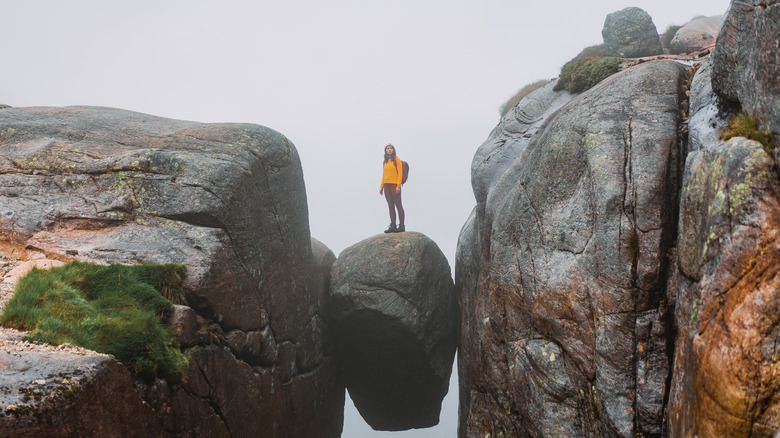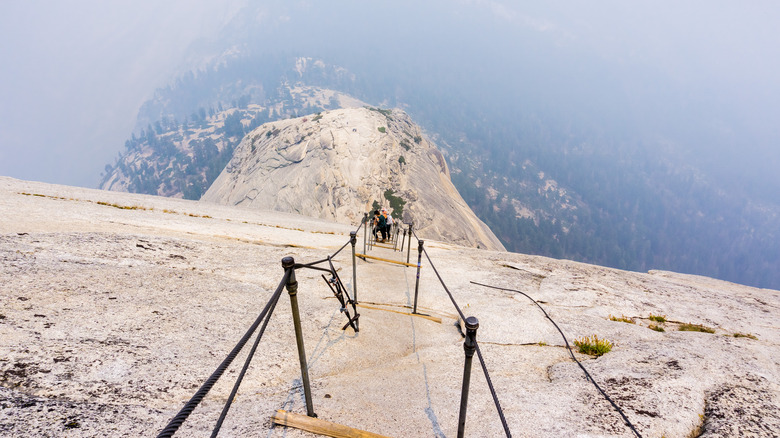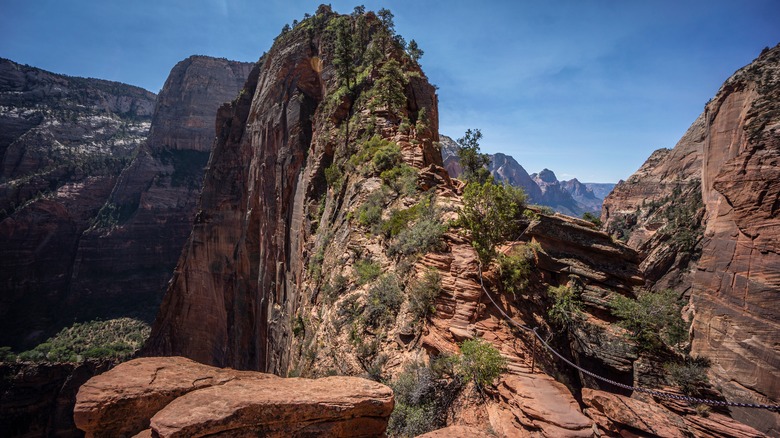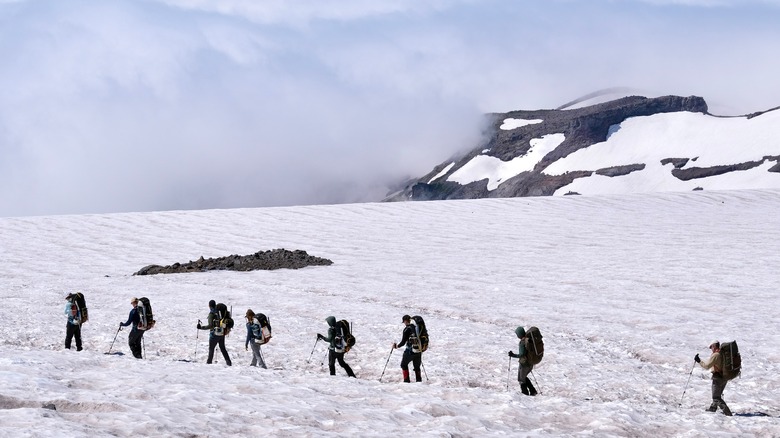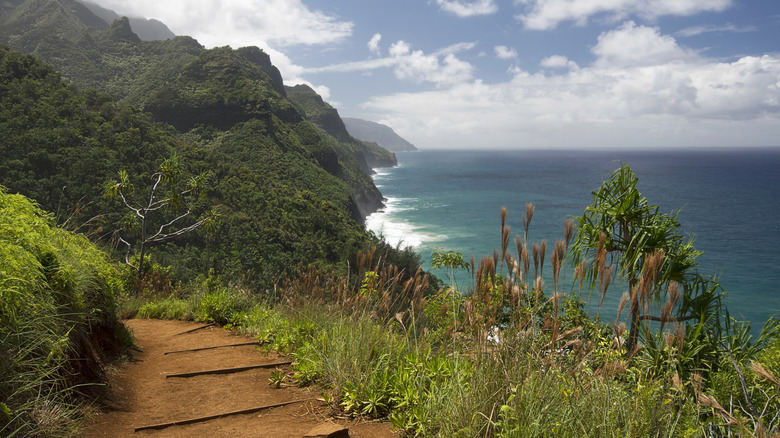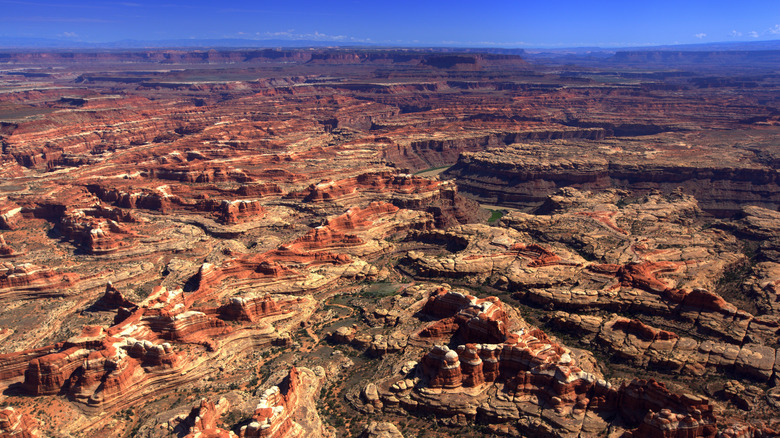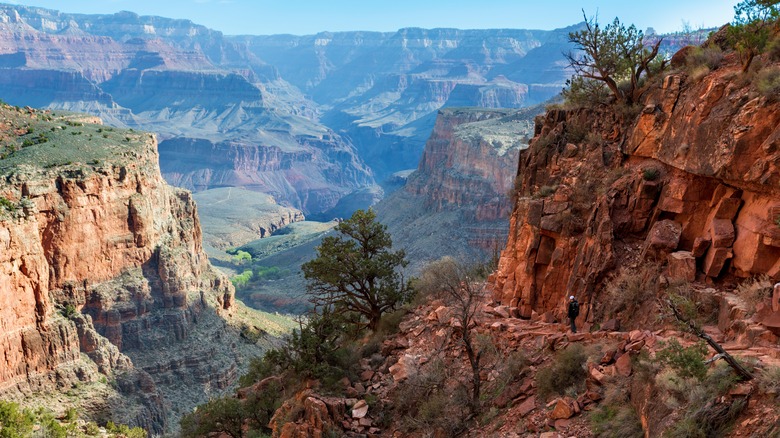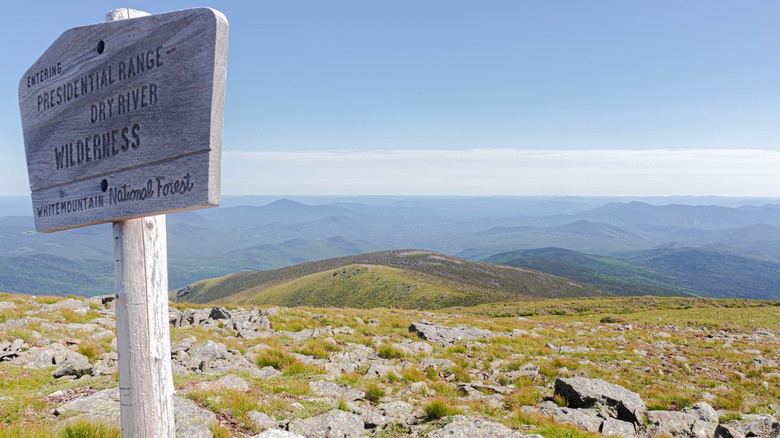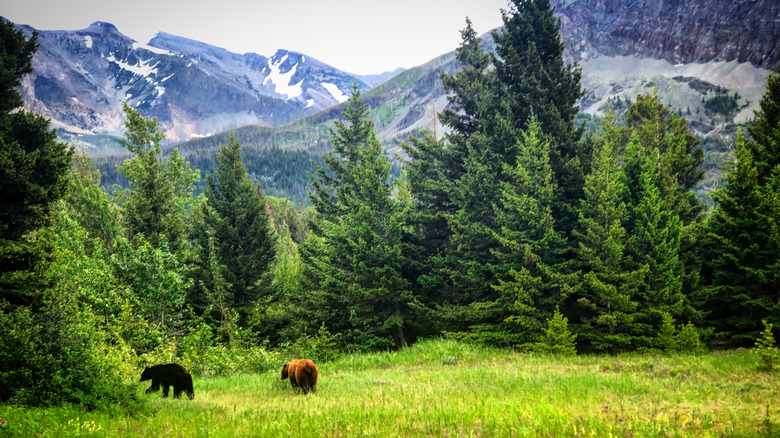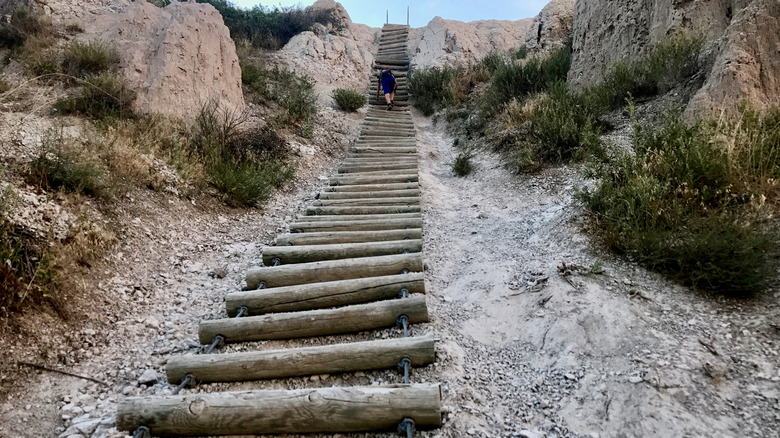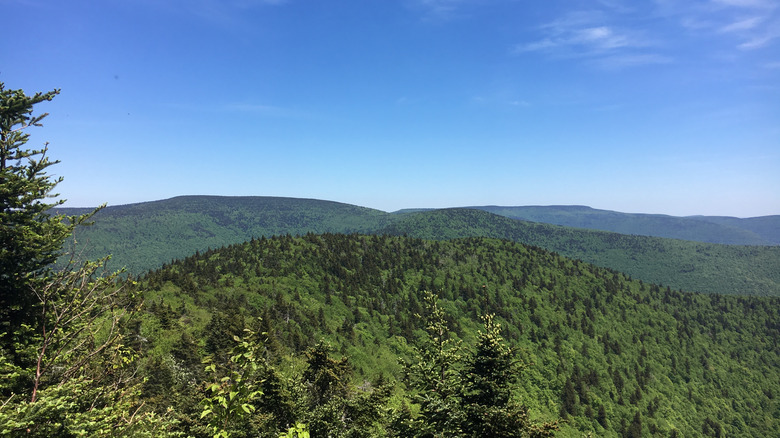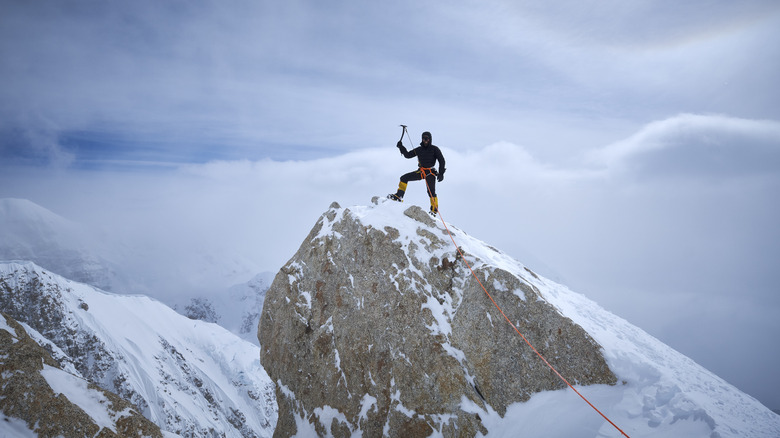11 Most Dangerous Hikes In The U.S.
Hiking is one of the most popular activities in the United States. Over 58 million Americans went hiking in 2021 and there are hundreds of thousands of miles of trails across the country. However, not every hike is a leisurely walk through the woods with beautiful views that make you appreciate being a creature on Earth. America is actually home to some of the most brutal and dangerous hikes on the whole planet. With its varied terrain from barren deserts to tropical forests flush with wildlife, U.S. hikes are no joke. Some hiking trails are so extreme that they're responsible for injuries and even deaths every single year.
The following 11 dangerous trails offer hikers otherworldly beauty and a thrilling escape into nature. Yet they can also be deadly. Hike at your own risk and be extra prepared if you ever decide to try your fate on one of these treacherous trails.
Half Dome, Yosemite National Park
While California's Yosemite National Park is surprisingly beginner-hiker friendly, the Half Dome hike is often the No. 1 item on serious hikers' bucket lists and it's extraordinarily high-risk. The trail is around 14 to 16 miles round trip and takes approximately 12 hours to complete. It's challenging the whole way through, but that's not what makes this journey so sketchy. From the moment you lay eyes on the last 400 feet of the Half Dome hike, you'll understand why it's considered one of the most dangerous hikes in America.
To finish the hike, participants must pull themselves vertically up a giant, sloped rock face 8,800 feet above sea level, the Half Dome. The most infamous part of the hike is the ascent up the cables. The two metal cables allow hikers to climb the last 400 feet to the summit without rock climbing equipment.
There are no trees or plant life to stop your fall, no dirt to dig your fingers into — it's just sheer rock the whole way down and nobody can help you if you fall along this stretch of the Half Dome. Over 20 people have died on this section of the trail and more than 60 have died on the whole hike. Injuries along Half Dome are also common, but the climb can be done safely by experienced, healthy hikers prepared with proper footwear who act smartly on this dangerous trek.
Angels Landing, Zion National Park
Angels Landing at Zion National Park is a favorite 5-mile-long hike in Utah, known across the country for providing some of the best views over Zion Canyon. However, it's also famous for being incredibly difficult and dangerous. Throughout the trail, hikers gain elevation super fast; they're constantly stuck in full-sun exposure and must rock scramble through sections of the trek.
The last half mile of the hike is the biggest threat along Angels Landing, though. It entails walking along a ridge with straight-down drops on either side with only a measly chain along the rock to help you keep your balance. There are some sections where the trail is just a couple of feet wide and has 1,000-foot plunges to death on either side of you. This section can get very wet or icy, too, making it even more dangerous.
The hike isn't very long and only takes around 4 hours, but it gains nearly 1,500 feet in elevation along the way. Once you reach the top, you are well over 1,000 feet from the ground and there aren't any big guardrails to protect you from toppling over the edge. It's gorgeous and exciting, but it's also terrifying and deadly. That's why permits are required for Angels Landing to ensure only a couple of people walk along that dangerous final stretch at a time.
Camp Muir, Mount Rainier National Park
The Camp Muir trail on Mount Rainier in Washington is one of the national park's most hazardous hikes. This 9-mile trek is a popular stop for climbers trying to get to the top of Rainier 14,410 feet above the ground, but it's also a common day hike. This entire mountain is dangerous, claiming the lives of hundreds, and many have passed away in the Camp Muir section.
The thing that makes the Camp Muir hike in Mount Rainier National Park so deadly is its unexpected freezing temperatures and storms. Remember, this is an extremely high-altitude hike gaining 4,600 feet over the course of the trail in a state on the border with Canada. You never know what's going to happen and it's scarily common for random snowstorms to rip through this area unexpectedly all the time.
In 2008, one man named Eduard Burceag died of hypothermia after a freak blizzard in June hit while he was hiking through the area. He ended up using his body's warmth to shield his wife and friend from 70 mph winds since they were all in summer clothes and he saved their lives. Hikers always have to be prepared for winter on the Camp Muir trail.
Kalalau Trail, Na Pali Coast State Wilderness Park
The hikes in Hawaii are world-renowned for their natural beauty, but the Kalalau Trail in Na Pali Coast State Wilderness Park has also built a reputation for its riskiness. The hike is 11 miles long each way and many visitors take on the challenge without fully understanding the risks of this hike. There are a lot of dangerous qualities about the Kalalau hike, though.
It is frighteningly commonplace for hikers to simply vanish while they're doing the Kalalau Trail. In 2005, a man named Daniel Marks disappeared after trying to find a way to get into the valley from the top and he's not the only one. As recently as 2022, a woman mysteriously vanished on this Hawaii hike. Most people believe that these disappearances are due to people falling and their bodies never being recovered.
Unstable rocks can fall from the cliffs above the Kalalau Trail and there are sharp drops from the trails that can become wet very often. Along much of the trail, you're side-by-side with a deadly cliff's edge. Over 100 people have reportedly died attempting the Kalalau Trail and way more have gotten injured. To make matters worse, there are limited emergency services around the area and no cell phone service on the hike, so it's a big problem for hikers who do get hurt.
Maze Overlook Trail, Canyonlands National Park
The Maze Overlook Trail in Utah's Canyonlands National Park is a dangerous U.S. national park trail that is not for amateur hikers. As one of the most remote hikes in the area, the trail is around 8 miles long and takes around 3.5 hours to finish completely. It is extremely easy to get lost since the terrain all looks so similar. Rocks falling and flash floods are also common on this trail. You really need to go out there prepared or you can easily end up in a life-threatening situation because there is absolutely nowhere to find water in the area.
However, it's not just the hike itself you have to worry about with the Maze — it's the long, desolate journey through the middle of nowhere to even reach the start of the hike. First, hikers must drive 2.5 hours to the Hans Flat Ranger Station along 46 miles of dirt road. From there, they need to take a high-clearance four-wheel drive vehicle or walk another 27 miles to the start of the actual Maze Overlook Trail.
That's already miles and miles of danger and if anything happens along that extremely isolated stretch, you're totally on your own. It's very easy for a small mishap to become life-threatening when you're in a place like Canyonlands. It takes most hikers three days to a week to attempt the Maze and the journey to it.
Bright Angel Trail, Grand Canyon National Park
The Bright Angel Trail may sound innocent enough, but it's actually one of the most perilous hikes in Arizona's Grand Canyon National Park and the country. There are reportedly more 911 calls and emergency rescues on the Bright Angel Trail than on any other trail in the state. It also happens to be one of the most-visited hikes in America with over 100,000 people finishing the trail every year.
At 18 miles long, it is one of the lengthiest hikes in the Grand Canyon, which is only the start of its danger. The most serious menace at Bright Angel is dehydration and things like heat stroke. It is painfully hot along the Bright Angel Trail and it's a long way to go, with hundreds of rescues due to the heat alone each year. It's very easy to slip on the trail's high, unstable ground if you get overheated and woozy.
The Presidential Traverse, White Mountain National Forest
The Presidential Traverse in New Hampshire's White Mountain National Forest is a harsh 18-mile-long hike that takes participants up with an 8,000-foot elevation gain, crossing several peaks along the way named after U.S. presidents like Washington, Madison, and Adams. It's part of the Appalachian Trail that's long, strenuous, and super high. There are a lot of potential dangers that come with being up that high for that long at nature's mercy.
The most dire of these risks is how the weather can change in a snap second and there is nowhere to hide if that happens since the trail is fully exposed most of the time. That's why hikers really need to be prepared for any type of weather when braving the Presidential Traverse. Due to the length of the Presidential Traverse and the fluctuating weather, it's not possible to complete this intense hike in just one day. Most hikers complete the hike as a two-to-three-day backpacking trip and camping or renting a cabin along the way.
Huckleberry Lookout, Glacier National Park
Not every danger along U.S. hiking trails is weather or terrain-related — sometimes it's the living creatures that you have to be worried about. The 6-mile Huckleberry Lookout trail in Montana's Glacier National Park, for example, is one of the more dangerous hikes in America because it's rampant with grizzly bears. Around 300 grizzly bears are living happily inside Glacier National Park.
Glacier National Park actually has one of the highest-density grizzly populations in the United States, with 30 bears lurking in every 1,000 square kilometers of space. One of these vicious bears' favorite snacks to grab is the huckleberries along the Huckleberry Lookout trail, which makes this hike extra dangerous for any mere human. It's possible to protect yourself from animals on the hike as long as you stay away from the berry bushes and bring bear spray along, just in case you cross paths with one of these predators.
The Notch Trail, Badlands National Park
The Notch Trail in South Dakota's Badlands National Park is one of the shorter dangerous hikes at just 1.5 miles long, but it has a few features that make it particularly terrifying. You are completely exposed to extremely hot weather without any trees and often no clouds for cover, so it can get draining very fast. The real challenge on the Notch Trail is its 50-foot wooden ladder that hikers must climb straight up to reach the top of the hike.
If it's rainy or wet at all, this climb can be very dangerous, but even in perfect conditions, it's nerve-wracking to scale the ladder for hikers with a fear of heights. While it's not as deadly as some of the other dangerous hikes, it's definitely not a pleasant fall if you get nervous and lose your grip. With that being said, the Notch Trail offers a level of danger that can be managed by fairly novice hikers if you're craving some adrenalin.
Devil's Path, Catskill Mountains
The aptly named Devil's Path in New York's Catskill Mountains is believed to be one of the most dangerous hikes on the East Coast, simply for how incredibly high the path takes you. It is a whopping 24 miles long and gets up to 9,000 feet of elevation change in some places. Throughout the hike, the terrain constantly changes from huge boulders to lofty cliff faces and there are a lot of ways to get hurt up there when you're tackling 24 miles. It's definitely a hike that should only be attempted by the most prepared, experienced hikers.
In many places, you have to rock scramble on your hands and feet to reach certain lengths of the trail. There aren't many water sources along the lengthy stretch of isolated trail. What's more, it's extremely steep and can get precariously icy out of the blue.
Mount Denali, Denali National Park & Preserve
Alaska's Mount Denali (aka Mount McKinley) is the definition of rugged wilderness, so it should come as no surprise that it's by far one of the most dangerous hikes in the United States. Mount Denali is actually the highest peak in North America and it is an extraordinarily dangerous hike no matter which of the many paths you take up to it. The most popular route to take to the top of Denali is the West Buttress trail, which is over 15 miles of climbing over icy ridges, steep snow-covered cliffs, and freezing cold temperatures.
Deaths are not uncommon at Denali with the most common causes being exposure to the elements and falling. Just last year in 2022 a New Jersey man collapsed and died while attempting to reach the top of Mount Denali. His death brought the grand total to 129 climbing deaths on Mount Denali in the past century.
It's a once-in-a-lifetime destination for hikers but there is only a very short season you can even attempt this hike because of the extreme conditions. It requires months of planning, minimum. It is strongly recommended to join a professionally guided expedition to attempt a trek up to the top of Mount Denali. Otherwise, your life is literally on the line with every step you take.
